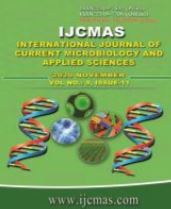


 National Academy of Agricultural Sciences (NAAS)
National Academy of Agricultural Sciences (NAAS)

|
PRINT ISSN : 2319-7692
Online ISSN : 2319-7706 Issues : 12 per year Publisher : Excellent Publishers Email : editorijcmas@gmail.com / submit@ijcmas.com Editor-in-chief: Dr.M.Prakash Index Copernicus ICV 2018: 95.39 NAAS RATING 2020: 5.38 |
Four species of oyster mushroom including P. djamor, P. eous, P. florida and P. citrinopileatus were tested for their yield performance, of them, the most promising yield was obtained in P. eous and P. djamor with minimum spawn running period. On subjecting them with additional substrates, sorghum grain was superior over other spawn substrates for quality spawn production in terms of earliness in growth of spawn and total yield followed by wheat grain. For, sporophore production, paddy straw was the best substrate followed by maize stalk. Additionally, Paddy chaffy grain spawn supplementation with bengal gram at 60g/kg increased the yield of P. djamor and P. eous with minimum spawn running time followed by green gram. Exocellulase, endocellulase and laccase activity was found to be maximum in paddy straw followed by maize stalk. P. djamor reached the maximum enzyme activity at 20 days after inoculation followed by P. eousand P. florida. The enzymes such as cellulase and laccase are responsible for degradation of cellulose and lignin present in the substrates. The efficiency of the enzyme production was positively correlated with the yield of mushroom. P. eous recorded more dry weight of mushroom than other species of Pleurotus spp. when dried at 55 to 60°C in an oven. Shelf life of P. eous was longer than that of P. djamor, P. florida and P. Citrino pileatus under different storage conditions.
 |
 |
 |
 |
 |